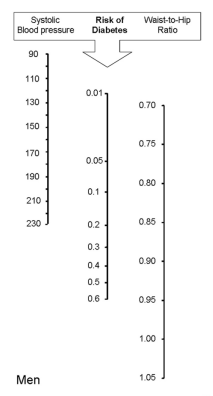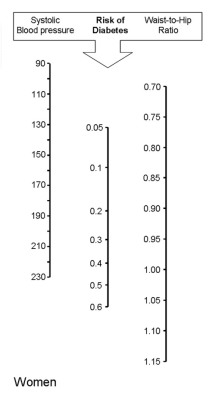Press Release
Xin giới thiệu cáo một công trình hợp tác nghiên cứu giữa Việt Nam (Bs Tạ Tuyết Mai, Bệnh viện Nhân dân Gia Định) và Viện nghiên cứu y khoa Garvan (Úc). Trong nghiên cứu rất công phu trên 2000 người ở TPHCM, các nhà nghiên cứu phát hiện 11% nam và 12% nữ mắc bệnh tiểu đường, tăng gần 3 lần so với 15 năm trước đây. Đặc biệt, công trình này phát triển một mô hình để tiên lượng bệnh rất đơn giản để tiên lượng nguy cơ tiểu đường cho một cá nhân. Người có công chính và đứng đằng sau nghiên cứu này là Bs Tuyết Mai, và người đứng đằng sau mô hình tiên lượng này chính là Ts Nguyễn Đình Nguyên, một cộng tác viên của Ykhoanet.com.
Ykhoanet.com
Công cụ đơn giản để chẩn đoán tiểu đường ở người Đông Nam Á
Các nhà nghiên cứu Việt Nam và Úc ước tính tỉ lệ bệnh tiểu đường và phát triển một mô hình đơn giản để phát hiện những cá nhân có nguy cơ mắc bệnh cao.
Bệnh tiểu đường là một bệnh mà khả năng sản sinh và điều tiết insulin của cơ thể trở nên suy giảm. Insulin là một kích thích tố có chức năng giảm lượng đường trong máu bằng cách di chuyển đường vào các tế bào để sản xuất năng lượng. Bệnh thường thấy ở những người có lối sống thiếu vận động cơ thể, hoặc chế độ ăn uống có nhiều chất béo hoặc nhiều đường.
Kết quả của công trình nghiên cứu cho thấy 11% nam và 12% nữ ở Thành phố Hồ Chí Minh mắc bệnh tiểu đường, nhưng họ không hề biết vì không có triệu chứng. Đó là chưa kể đến khoảng 4% đã được chẩn đoán mắc bệnh tiểu đường.
Công trình nghiên cứu được thực hiện trên 721 nam và 1,421 nữ tuổi từ 30 đến 72. Các tình nguyện viên được chọn ngẫu nhiên từ 30 phường thuộc Thành phố Hồ Chí Minh.
Với một dân số 6.4 triệu người, và 38% trên tuổi 30, những phát hiện này cho thấy khoảng 360,000 cư dân thành phố đang mắc bệnh tiểu đường, và nhiều người không biết rằng họ đang bị tiểu đường.
Với những dữ liệu thu thập và phân tích, các nhà nghiên cứu tìm cách phát triển một công cụ đơn giản nhất để tiên lượng nguy cơ bệnh. Họ phát hiện 2 yếu tố nguy cơ: cao huyết áp và tỉ số eo-mông.
Ở những người có tỉ số eo-mông cao và khi huyết áp tăng cao có nguy cơ mắc bệnh tiểu đường gấp 6 lần ở nam và 4 lần ở nữ so với người có tỉ số eo – mông bình thường và không bị cao huyết áp.
Giáo sư Nguyễn Văn Tuấn và Giáo sư Lesley Campbell từ Viện nghiên cứu y khoa Garvan, hợp tác cũng Bác sĩ Tạ Thị Tuyết Mai từ Bệnh viện Nhân dân Gia Định của Thành phố Hồ Chí Minh, đã công bố phát hiện của họ trên tập san Diabetologia.
“Trong vài năm gần đây, cách ăn uống và tiêu thụ thực phẩm đã thay đổi nhanh chóng ở Việt Nam, nhất là ở những thành phố nơi mà người dân sống theo lối sống phương Tây,” Giáo sư Nguyễn nói.
“Các nhà hàng thức ăn làm sẵn và thức ăn nhanh ở mọi nơi. Một điều nghịch lí là ở Á châu, tiểu đường hay thấy ở những người giàu có, những người có điều kiện ăn thức ăn kiểu phương Tây, trong khi đó ở Úc, tiểu đường hay thấy ở những người có thu nhập thấp.”
“Hầu như ai cũng thấy rằng tiểu đường đang trở thành một đại dịch trên thế giới, và nghiên cứu này cho chúng ta biết thêm về qui mô của bệnh ở Việt Nam.”
“Dù không đề cập đến trong bài báo của chúng tôi, nhưng một tỉ lệ tương tự cũng được tìm thấy ở Thái Lan. Do đó, chúng tôi cảm thấy tự tin rằng kết quả của chúng tôi có thể áp dụng cho các cư dân vùng Đông Nam Á như Mã Lai, Singapore, Campuchea và Lào. Chúng tôi tin rằng kết quả của chúng tôi cũng có thể áp dụng cho các cộng đồng người Đông Nam Á trên thế giới.”
“Mô hình mà chúng tôi trình bày trong nghiên cứu này sẽ giúp cho bác sĩ và nhân viên y tế ước tính nguy cơ tiểu đường của một cá nhân một cách nhanh chóng, dễ dàng, và rẻ. Nếu nguy cơ cao, cá nhân đó nên xét nghiệm đường trong máu.”
Công cụ chúng tôi phát triển là một biểu đồ tiên lượng (nomogram) gồm 3 cột song song trên một tờ giấy. Cột phía trái chỉ huyết áp, cột phía phải là tỉ số eo-mông, và cột chính giữa chỉ nguy cơ tiểu đường. Chỉ cần kẽ một đường thẳng từ huyết áp và tỉ số eo-mông, và điểm gieo chéo giữa đường thẳng và cột chính giữa chính là xác suất mắc bệnh tiểu đường.
|
|
|
|
Hình 1: Mô hình tiên lượng bệnh tiểu đường cho nam (biểu đồ trái) và nữ (biểu đồ phải) người Việt (Copyright: Diabelogia và Ta Thi Tuyet Mai, et al)
Giáo sư Lesley Campbell, Giám đốc Trung tâm tiểu đường của Bệnh viện St Vincent’s, tin rằng công cụ này sẽ rất có ích cho các nước đang phát triển.
“Ở Úc, chúng tôi có tiền để sử dụng nhiều xét nghiệm tinh vi và phức tạp, nhưng ở các nước đang phát triển, chúng ta cần những công cụ đơn giản mà nhân viên y tế có thể dùng ma không cần nhiều huấn luyện – và đây chính là công cụ đó,” Giáo sư Campbell nói.
“Không ai khuyến cáo nên tầm soát bệnh tiểu đường một cách không chọn lọc, bởi vì cách làm đó rất tốn kém và giá trị thì thấp. Vì thế, chúng ta cần phải có mô hình tiên lượng để phân lập nhóm cần được tầm soát tiểu đường với nhóm không cần xét nghiệm.”
“Ở bất cứ sắc dân nào, tỉ số eo – mông là một yếu tố rất tốt cho tiên lượng bệnh tiểu đường, tử vong, và bệnh tim mạch. Đó là một đo lường lâm sàng rất đơn giản mà chúng ta có thể sử dụng. Thước đo này đã được chứng minh trong các nghiên cứu quần thể lớn khoảng 20 năm trước. Trong công trình nghiên cứu INTERHEART, tỉ số eo - mông là một chỉ số lâm sàng tiên lượng tốt nhất cho bệnh tim mạch, tốt hơn cả cholesterol.”
“Nhưng vì tỉ số eo-mông rất đơn giản – chỉ cần dùng thước dây để đo – nên người ta có vẻ không dành cho thước đo này một sự kính trọng thích hợp.”
“Ở Úc, chỉ số tiên lượng bệnh tiểu đường tốt nhất là tiền sử gia đình. Ở các nước đang phát triển, phần lớn người dân không biết họ bị tiểu đường, hay gia đình có ai bị tiểu đường.”
“Do đó, công cụ mà nghiên cứu này phát triển thật sự đơn giản và rẻ tiền – Tôi yêu nó vì hai đặc tính này,” Giáo sư Campbell nói.
===
Simple diagnostic tool predicts Type 2 diabetes in South East Asians
Australian and Vietnamese researchers have estimated the current prevalence of Type 2 diabetes in Vietnam, and have developed a simple tool for identifying individuals at high risk.
Often triggered by sedentary lifestyles and high-fat or high-sugar diets, diabetes is a condition where the body becomes less able to make and use insulin, a hormone that reduces sugar in the blood by moving it into cells for energy use.
The new study found that the prevalence of undiagnosed diabetes is about 11% for men and 12% for women – in addition to roughly 4% of the population already diagnosed with diabetes.
Using the electoral roll, the study was based on 721 men and 1,421 women, aged between 30 and 72, randomly sampled from 30 suburbs throughout Ho Chi Minh City.
In the city of 6.4 million residents, the findings suggest that around one million have Type 2 diabetes, many of whom are unaware of the fact.
With the data they gathered, researchers set out to create the simplest and most effective tool to predict risk, narrowing all potential risk factors down to two: high systolic blood pressure and high waist-to-hip ratio.
When levels of central obesity and hypertension were high, the odds of developing diabetes increased by over sixfold in men and fourfold in women.
Professors Tuan Nguyen and Lesley Campbell from Sydney’s Garvan Institute of Medical Research, in collaboration with Dr Mai Ta from Nhan dan Gia Dinh hospital in Ho Chi Minh City, have published their findings in the journal Diabetologia, now online.
“Dietary patterns have been changing dramatically in Vietnam in recent years, particularly in the cities as they become more westernised,” said leading author Professor Nguyen.
“There are fast food outlets everywhere. The paradox is that in Asia, diabetes is commonly found among well off people, who can afford western-style fast food, whereas in Australia it’s commonly found in socio-economically disadvantaged groups.”
“While everyone is aware that diabetes is reaching epidemic proportions around the world, this study tells us the magnitude of the problem in one Vietnamese city.”
“It’s not mentioned in our paper, but a similar undiagnosed prevalence of diabetes was also found in Thailand. Because of that, we feel very confident that we can extrapolate our findings to other parts of South East Asia including Malaysia, Singapore, Cambodia and Laos. We also believe they are applicable to Southeast Asian communities in Australia and around the world.”
“Our diagnostic tool will allow doctors and health workers to determine an individual’s risk quickly, easily and cheaply. If the risk is high, the individual should have specific glucose testing.”
The tool is a ‘nomogram’ that shows three different measurements, represented as three parallel lines on paper. The line to the left shows systolic blood pressure, the one to the right shows waist-to-hip ratio, the one in the middle shows risk of diabetes. A line is drawn between an individual’s scores on the outer lines. The point at which it intersects the central line indicates risk.
Lesley Campbell, Director of St. Vincent’s Diabetes Centre, Professor of Medicine at the University of NSW and senior clinical researcher at Garvan, believes the tool will be very useful in developing countries generally.
“In Australia, we have the finances to use many subtle and sophisticated tests, but in developing countries, it’s critical that you have screening test that can be used by workers with only basic training – and that’s what this is,” she said.
“No-one in any country recommends universal screening of everybody because it’s too expensive and the yield is too low. So you have to have risk predictors to separate who is worth screening.”
“Waist-to-hip ratio is the best predictor of diabetes, mortality and heart disease, no matter where you live. It’s the best simple clinical measure that you can ever do. It’s been proven since the 1980s in huge population studies; it’s been proven in the INTERHEART study as the best indication of cardiovascular risk factor, better than cholesterol.”
“Unfortunately, because it’s so straightforward – you just use a tape measure –people don’t seem to respect it enough.”
“In Australia, the best predictor of diabetes is a strong family history of the disease. In developing countries, most people don’t know whether or not there’s diabetes in the family.”
“The measuring tool that comes out of this study is really simple and cheap – I love it because of that.”
===
http://news.smh.com.au/breaking-news-national/diabetes-alarm-in-southeast-asia-20100707-zz8x.html
Diabetes alarm in South-East Asia
DANNY ROSE
July 7, 2010 - 12:09AM
AAP
Australian researchers have sounded the alarm over rising rates of diabetes across South-East Asia, linked to an increasingly westernised lifestyle.
The study in Ho Chi Minh City, Vietnam found 11 per cent of men and 12 per cent of women had developed type 2 diabetes, but they did not know it so the disease went untreated.
This was on top of four per cent of the population diagnosed with the disease triggered by poor diet and obesity, said professors Tuan Nguyen and Lesley Campbell of Sydney's Garvan Institute of Medical Research.
"Dietary patterns have been changing dramatically in Vietnam in recent years, particularly in the cities as they become more westernised ... there are fast food outlets everywhere," Prof Nguyen said.
"In Asia, diabetes is commonly found among well-off people, who can afford western-style fast food whereas in Australia it's commonly found in socio-economically disadvantaged groups."
Prof Nguyen said the study findings added to a growing pool of research that suggested the disease was now "reaching epidemic proportions around the world".
In particular, he said, the findings in Vietnam echoed the results of a similar investigation in Thailand.
"Because of that, we feel very confident that we can extrapolate our findings to other parts of South-East Asia including Malaysia, Singapore, Cambodia and Laos," Prof Nguyen said.
"We also believe they are applicable to South-East Asian communities in Australia and around the world."
Type 2 diabetes is caused by a diet high in fat or sugar and a lack of exercise, and without treatment the condition leads to worsening health problems including heart disease, vision loss and lower limb amputation. Ultimately it leads to kidney failure.
About three per cent of Australians have been diagnosed with type 2 diabetes while about another three per cent of the population are thought to be undiagnosed.
Australian health officials are tracking a third category - 16 per cent of Australians who have the earliest signs of the disease or "pre-diabetes".
"If you add it up, it makes about 23 per cent of the (Australian) population at risk," Prof Campbell said.
"Who knows what we would find if we went and looked at this in the same way in the Third World.
"Unfortunately, we are watching, in just over a generation, a very rapid increase in diabetes in the Third World nations."
Prof Campbell said a "sad story" was emerging in developing nations, where hunger and poverty co-existed with diseases from the affluent West, but without a western-standard health system.
In a bid to address this, the researchers have also developed a low-tech but accurate diagnostic tool that could be used to identify those likely to have undiagnosed diabetes.
The test requires only a patient's blood pressure to be checked and compared against their hip and waist measurements.
"In developing countries, it's critical that you have screening tests that can be used by workers with only basic training - and that's what this is," Prof Campbell said.
The research is published in the journal Diabetologia.




